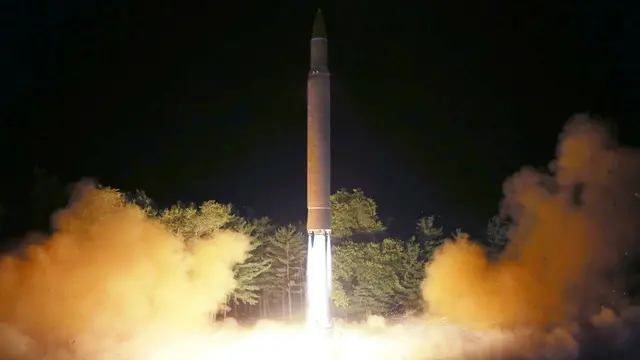The United States and South Korea conducted a live-fire exercise after the Democratic People's Republic of Korea (DPRK) successfully launched a second intercontinental ballistic missile (ICBM) on Friday, the U.S. military said.
According to Reuters, a U.S. military statement said the exercise used missiles that were fired into "territorial waters of South Korea along the East Coast."
South Korea President Moon Jae-in has also ordered his top military officials to begin discussing with the US forces to enhance their joint defense capabilities and the reliable expanded deterrence capability, including the early installation of the remaining four launchers of the Terminal High Altitude Area Defense (THAAD) system, reversing his precious decision to suspend the deployment until an environmental assessment is made.
A man watches a television screen showing a video footage of North Korean leader Kim Jong-Un during the North's latest test launch of an intercontinental ballistic missile (ICBM), at a railway station in Seoul on July 29, 2017. /AFP Photo
"Such discussion is currently going on, but further consultations are needed for the specific issues of when and how," Moon Sang-gyun, spokesman at the Ministry of National Defense said in a press briefing on Monday.
"Full-swing discussions with the US will also start soon for the deployment of additional launchers," Moon said, adding the discussion will be followed by the process of actual deployment.
THAAD /Xinhua Photo
However, an official from Seoul's presidential office Cheong Wa Dae said that the early deployment of THAAD will not mean an escape from the environment test, which will continue regardless of the installation.
And Defense Minister Song Young-moo even said to lawmakers that the "temporary THAAD deployment" also had the meaning of reconsidering if people feel anxious about it.
According to the report of Yonhap News Agency, President Moon will hold telephone discussions with his US counterpart Donald Trump over ways to deal with the so-called threats from the DPRK, though the exact date has not been decided.
The two sides are also pushing for the first meeting between Defense Minister Song and his US counterpart Jim Mattis before the alllies' annual Security Consultive Meeting slated for October, according to Seoul's defense ministry.
The envisioned meeting is likely to focus on curbing DPRK's nuclear and missile threats and issues between the two allies, including a revision of a ballistic missile guideline and a US missile defense system, said the ministry.
Washington and Seoul have a quite similar stance on the so-called DPRK threats and last July the two agreed to deploy the THAAD system in South Korea's Seongju county, which was once a Buddhist pilgrimage site but now became a center for anti-THAAD protest.
Local residents take part in a protest against the decision to deploy the Terminal High Altitude Area Defense (THAAD), in Seoul, South Korea, July 11, 2016. /Xinhua Photo
On Monday about 40 protesters held a rally in Seoul to protest the additional deployment of the missile shield system.
Farmers worried that the system's advanced radar will damage local melon crops and make the small town an attack target. And some believed the system cannot protect the South Korean people from DPRK's ICBM and the government's intention of the deployment was to detect the DPRK's missiles upon the US request.
(CGTN)
 简体中文
简体中文

